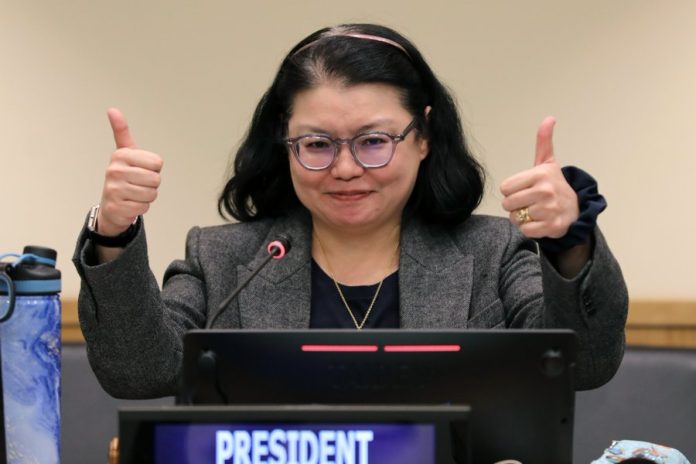It has been almost two decades in the making but on Saturday night in New York, after days of gruelling round-the-clock talks, UN member states finally agreed on a treaty to protect the high seas.
A full day after the deadline for talks had officially passed, the conference president, Rena Lee of Singapore, took to the floor of room two of the UN headquarters in New York and announced the treaty had been agreed. At a later date, the delegates will meet for half a day to formally adopt the text. She made it clear the text would not be reopened.
“In Singapore, we like to go on learning journeys and this has been the learning journey of a lifetime,” Lee said.
She thanked delegates for their dedication and commitment. “The success is also yours,” she told them.
She received cheers and a standing ovation from delegates in the room who had not left the conference hall for 48 hours and worked through the night in order to “get the deal done”.
The historic treaty is crucial for enforcing the 30×30 pledge made by countries at the UN biodiversity conference in December, to protect a third of the sea (and land) by 2030. Without a treaty this target would certainly fail, as until now no legal mechanism existed to set up MPAs on the high seas.
Covering almost two-thirds of the ocean that lies outside national boundaries, the treaty will provide a legal framework for establishing vast marine protected areas (MPAs) to protect against the loss of wildlife and share out the genetic resources of the high seas. It will establish a conference of the parties (Cop) that will meet periodically and enable member states to be held to account on issues such as governance and biodiversity.
Ocean ecosystems produce half the oxygen we breathe, represent 95 percent of the planet’s biosphere and soak up carbon dioxide, as the world’s largest carbon sink. Yet until now, fragmented and loosely enforced rules governing the high seas have rendered this area more susceptible than coastal waters to exploitation.
Veronica Frank, political adviser for Greenpeace, said that while the organisation hadn’t seen the latest text, “we are really happy. The world is so divided and to see multilateralism supported is so important”.
“What’s really important is now to use this tool to develop this 30×30 target into force really quickly.”
The Pew Charitable Trust welcomed the “landmark international agreement”.
“High seas marine protected areas can play a critical role in the impacts of climate change,” said Liz Karan, director of Pews’s ocean governance project. “Governments and civil society must now ensure the agreement is adopted and rapidly enters into force and is effectively implemented to safeguard high seas biodiversity.”
The High Ambition Coalition – which includes the EU, U.S, UK and China – were key players in brokering the deal, building coalitions instead of sowing division and showing willingness to compromise in the final days of talks. The Global South led the way in ensuring the treaty could be put into practice in a fair and equitable way.
It is the third time in less than a year that member states have hunkered down in the UN’s headquarters in New York to thrash out a “final” deal.
The negotiations, which ran over two weeks from 20 February were the fifth round of talks after earlier negotiations ended last August without agreement.
One of the key stumbling blocks, which divided developing and developed nations, was how to fairly share marine genetic resources (MGR) and the eventual profits. MGR, which consist of the genetic material of deep-sea marine sponges, krill, corals, seaweeds and bacteria, are attracting increasing scientific and commercial attention due to their potential use in medicines and cosmetics.
Others sticking points included the procedure for creating marine protected areas and the model for environmental impact studies of planned activities on the high seas.
In a move seen as an attempt to build trust between rich and poor countries, the European Union pledged €40m (US$42m) in New York to facilitate the ratification of the treaty and its early implementation.
Monica Medina, the U.S assistant secretary for oceans, international environment and scientific affairs, who attended the negotiations in New York, said: “We leave here with the ability to create protected areas in the high seas and achieve the ambitious goal of conserving 30% of the ocean by 2030. And the time to start is now.”
She said the US was pleased to agree on the major element of a high seas treaty that includes a strong, coordinated approach to establishing marine protected areas.
Rebecca Hubbard, director of the High Seas Alliance, said: “Following a two-week-long rollercoaster of a ride of negotiations and superhero efforts in the last 48 hours, governments reached agreement on key issues that will advance protection and better management of marine biodiversity in the high seas.”
“What happens on the high seas will no longer be ‘out of sight, out of mind,” said Jessica Battle of WWF in a statement after leading the group’s team at the negotiations. “We can now look at the cumulative impacts on our ocean in a way that reflects the interconnected blue economy and the ecosystems that support it.”.
SOURCE: THE GUARDIAN/PACNEWS














